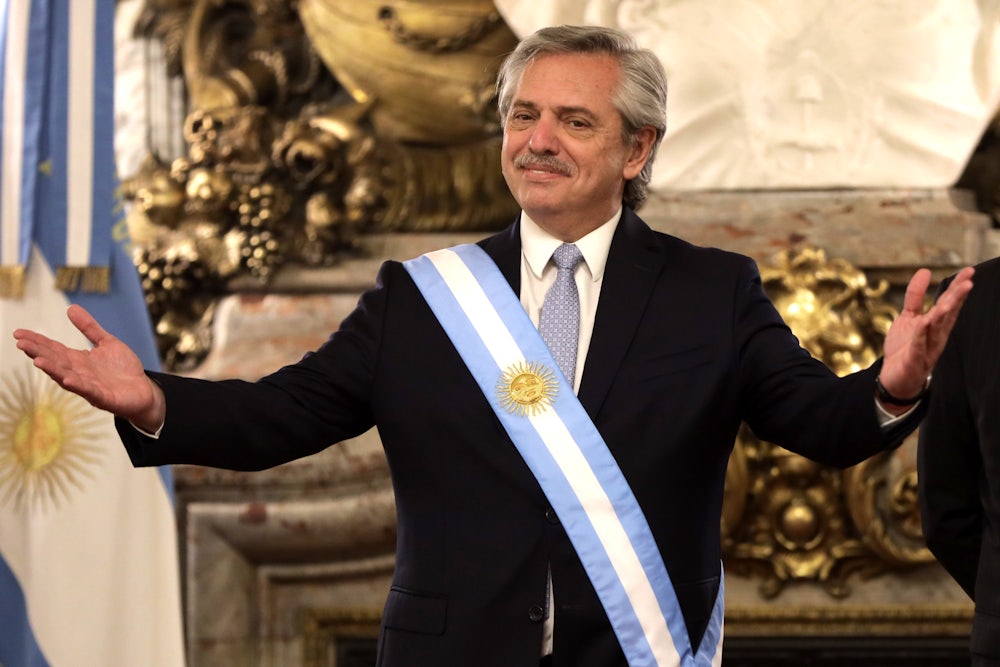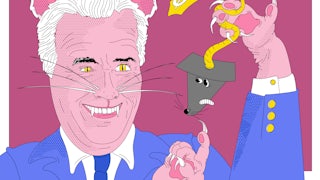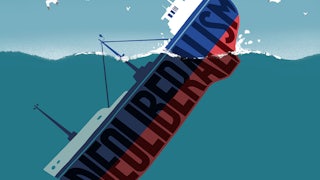Argentina’s currency, the peso, is getting yet another face-lift. Last month, Peronist President Alberto Fernández announced a new “family” of paper bills, fulfilling a campaign promise that was ostensibly delayed by the Covid-19 pandemic. This has become a rite of passage of sorts for the nation’s leaders: The latest bills will be the fourth partial or total redesign since 2011, continuing a trend now spanning three administrations across the country’s political and ideological spectrum. Though this is a boon for currency design specialists, spare a thought for all who need to swiftly identify the smattering of bills now in circulation.
Fernández’s announcement came amid a projected yearly inflation rate of over 50 percent; this past March alone, inflation reached 6.7 percent, the highest number for one month in decades, and it has surpassed 50 percent in two of the past three years. Certainly, inflation can motivate governments to modify their country’s array of bill denominations: As prices rise, higher-number bills reduce transit costs for banks stocking ATMs and simplify cash transactions. But Fernández did not, as some of his opponents on the right expected or hoped, add a 2,000 peso or 5,000 peso note. The highest denomination will remain 1,000 pesos, introduced by Fernández’s predecessor, neoliberal businessman Mauricio Macri, in 2017.
Macri had already introduced a 500 peso and 200 peso note in response to the peso’s eroded purchase power in 2016. The highest note before then had been 100 pesos, in circulation since 1999. Macri’s predecessor, current Vice President Cristina Fernández de Kirchner, had likewise refused to issue notes with higher nominal value during her terms as president from 2007 to 2015. She was said to believe that doing so would heighten Argentina’s inflationary spiral, and that logic has also inflected Fernández’s refusal to issue greater bills. The president of Argentina’s central bank, meanwhile, claimed that the lack of higher denominations will encourage online commerce, a stretch in a country with an informal economy equivalent to around 25 percent of its gross domestic product.
Given the material unimportance of money’s look, it’s clear that economic, aesthetic, or security concerns are not driving these changes. Fernández is a Peronist—a follower of Juan Domingo Perón, an army officer who rose meteorically to power in the 1940s by enacting policies that benefited poor and working-class Argentines and challenged a powerful aristocracy. The commitment of Perón’s first wife, Eva, to social justice made her, in the years before her untimely death, Peronism’s defining icon—and a figure who remains controversial today. (She and her husband often neared authoritarianism, and their sympathy for Mussolini is well documented.) Macri, in addition to issuing higher-value notes, had redesigned existing notes, replacing historically significant figures with animals native to Argentina. Fernández is undoing this measure; the figures restored include General José de San Martín, who led Argentina’s revolutionary war. Though the Fernández administration has emphasized the increased presence of women, Juana de Azurduy and María Remedios del Valle, prominent early nineteenth-century military leaders, share their respective notes with men. Evita is the only woman to receive lone billing, on the 100 peso note to which Fernández de Kirchner allocated her in 2011.
For Fernández and his predecessors on either side, redesigning paper money is a way to convey a government’s values and policies through something tangible with which the public engages every day. But ultimately these redesigns do not address deep-rooted and worsening economic woes.
Argentina’s currency has historically been a shaky matter. In the 1970s and 1980s, two separate versions of the peso—the “Peso Ley” and the “Peso Argentino”—were used and eventually replaced by the “austral” denomination in 1985. A hyperinflationary period in the late ’80s effectively nullified the austral’s value (notes up to 500,000 australes circulated; in May 1989, inflation reached 114 percent for the month). Carlos Menem, president from 1989 to 1999, introduced a bill cutting four zeros off the austral and renaming it the peso, attempting to parallel Argentina’s monetary system to the U.S. dollar. Menem also declared a one-to-one (“uno a uno”) fixed exchange rate between the peso and the dollar, a measure that contributed to the worst economic crisis in Argentine history in 2001. When the dollar’s value increased in the late ’90s, Argentina’s exports ceased to be competitively priced, eventually leading to mass unemployment. This led to a cash shortage so severe that the government mandated that banks withhold people’s money, and particularly their U.S. dollars, to pay off debts, a move later called a “corralito.” Many never recovered their money, and the measure heightened the public’s already great distrust of financial institutions.
Though the country mostly returned to stability in 2003, by 2012 inflation had begun to accelerate again, with the official inflation rate circling 12 percent and private consulting firms claiming the number was closer to 25 percent. The peso depreciated around 14 percent against the dollar despite currency exchange restrictions meant to stabilize the exchange rate. That year, President Fernández de Kirchner announced the first currency redesign, which put Evita on the 100 peso note. Per Fernández de Kirchner, this bill had been in the works after Evita’s death in 1952, and a preliminary design survived the decades after a 1955 coup deposed Perón and proscribed Peronism, hidden behind a drawer in Argentina’s mint. The bill’s roll-out was controversial, with complaints that businesses were refusing to accept it. Kirchner suggested, in response, that “it wasn’t the bill, we know what it was … Evita is what bothered them.”
The inflationary trend continued through the remaining years of Kirchner’s presidency. In 2014, she announced two more redesigned notes: a 50 peso bill featuring the Falkland or Malvinas Islands, to which Argentina has held a longtime territorial claim; and a 10 peso note, preserving the figure of Manuel Belgrano but including subtle homages to Juana Azurduy and other facets of revolutionary, military mythos. Fernández de Kirchner and her husband—former President Nestor Kirchner, who ruled from 2003 to 2007 and died in 2010—often leaned on the language of war as a metaphor for governance and politics.
While campaigning as the opposition candidate in 2015, Macri—a right-wing businessman turned politician and the son of one of Argentina’s wealthiest impresarios—and his party called for new bills with higher denominations. After taking over from Kirchner in late 2015, Macri’s administration began work on a new “family” of notes themed around “Argentina’s Autochthonous Animals” and devoid of historical figures. These bills, as the documentary produced around them maintains, were meant to “highlight the generosity of our country’s fauna, celebrate life, and defend federalism.” Macri’s administration argued that animals would be less divisive and unite all Argentines, leaving politics out of it and focusing on environmentalism. This was interpreted specifically as a reaction against Fernández de Kirchner’s redesigns. The out-of-power Kirchnerists, as Fernández de Kirchner’s followers are known, soon argued that beneath the claim to a higher representation there was also a distaste for history and historical memory.
Macri’s relationship to historical memory has been the subject of much criticism. In 2016, he claimed not to know whether Argentina’s last civic-military dictatorship, which lasted from 1976 to 1983, had disappeared (i.e., extrajudicially kidnapped and murdered without record) 9,000 or 30,000 people. The 30,000 figure—an estimate, impossible to confirm by virtue of the very nature of the crime it indexes—represents the long struggle for justice and remembrance that has racked the country since the end of the dictatorship. Macri also claimed that what had occurred was a “dirty war,” equating the genocidal program of the dictators with the actions of the small guerrilla groups that the military massacred. Justice for the dictatorship’s atrocities was a central part of the Kirchners’ political agenda.
Many, including both Fernández de Kirchner and Alberto Fernández, see a continuity between Macri’s lack of interest in historical memory and his choice of “autochthonous animals” for currency. At the launch ceremony for his administration’s new notes, Fernández said, “Some want to erase history; they want us not to remember,” in reference to Macri’s “autochthonous animals” bills. Macri, meanwhile, saw his redesign as part of what he termed the “sincerification of the economy,” meant to acknowledge and curtail excess government spending, though it ultimately led to harsh austerity measures. Fernández has recently reached an agreement with the International Monetary Fund to refinance the $44 billion of debt that the Macri administration incurred, the biggest loan in the organization’s history.
Announcing the new currency, Fernández asserted that “currency is, above all else, also a symbol of sovereignty and an instrument of economic policy that we will never resign.” Economic sovereignty in particular has always been a pillar of Kirchnerism, exemplified (if not mythologized) by Nestor Kirchner’s payment of billions of dollars’ worth of debt to the IMF in 2005. Fernández’s recent deal with the IMF did not satisfy Fernández de Kirchner’s faction of the party, which felt that the president was too readily agreeing to the IMF’s terms. The two Peronist leaders feuded publicly, and some pundits saw a growing threat to their coalition. Fernández’s economic minister, Martín Guzmán, led the IMF deal, and his approach has come under significant criticism from party factions. Most recently, the interior commerce secretary, a Fernández de Kirchner loyalist, resigned from his post over differences with Guzmán.
Economic instability has mounted over the past decade in Argentina, and though 2001 continues to represent a nadir of unrest and misery, poverty has grown to encompass nearly 40 percent of the country’s population, with around 65 percent of all children living in poverty. These problems have only grown during the Fernández de Kirchner, Macri, and Fernández administrations. All three have positioned currency redesigns as central to their economic programs. But in the end, redesigns are materially irrelevant measures—and perhaps Argentina’s political leaders prefer them for that very reason. These redesigns assert a commitment to action; reversing years of rising inflation, devaluation, and structural poverty and inequality is a far more difficult task. It remains to be seen whether, after Fernández’s announcement, relief is in sight for the nearly 20 million Argentines living below the poverty line. But this much is clear: People can’t eat money, no matter what it looks like.






